巨大儿的分娩方式及其妊娠结局
- 格式:doc
- 大小:115.00 KB
- 文档页数:4
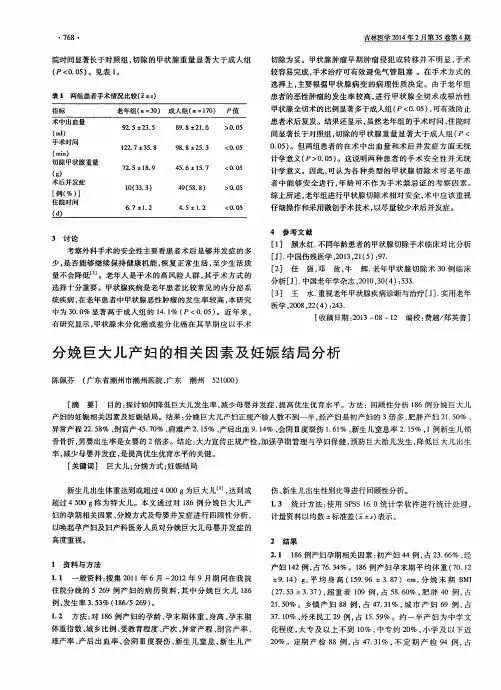
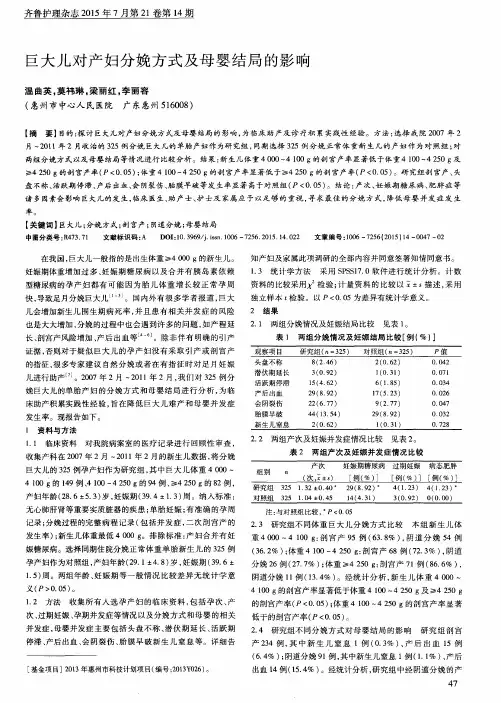
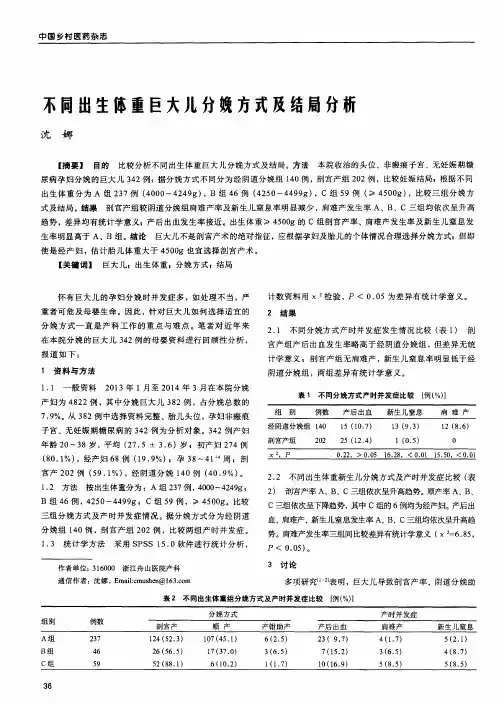

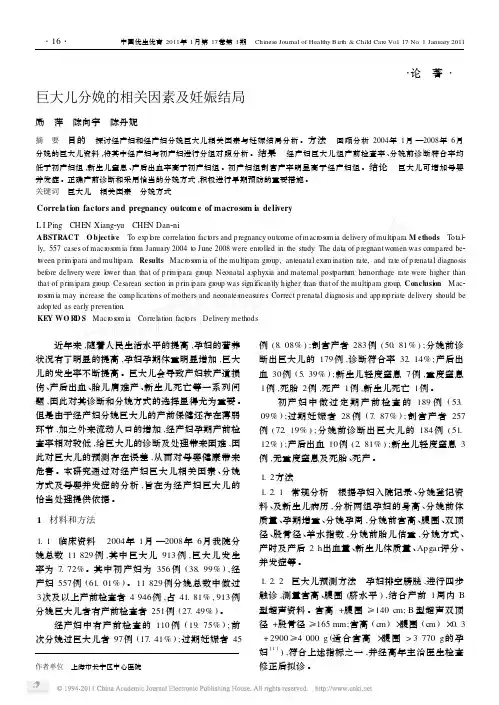
・论 著・巨大儿分娩的相关因素及妊娠结局励 萍 陈向宇 陈丹妮摘 要 目的 探讨经产妇和经产妇分娩巨大儿相关因素与妊娠结局分析。
方法 回顾分析2004年1月—2008年6月分娩的巨大儿资料,将其中经产妇与初产妇进行分组对照分析。
结果 经产妇巨大儿组产前检查率、分娩前诊断符合率均低于初产妇组,新生儿窒息、产后出血率高于初产妇组。
初产妇组剖宫产率明显高于经产妇组。
结论 巨大儿可增加母婴并发症。
正确产前诊断和采用恰当的分娩方式,积极进行早期预防的重要措施。
关键词 巨大儿 相关因素 分娩方式Correl a tion factors and pregnancy outcom e of macrosom i a deli veryL I Ping CHEN Xiang 2yu CHE N Dan 2niABSTRACT O bjecti ve To exp l ore correlati on fact ors and p regnancy outcome of macr os o m ia delivery of multi para .M ethods Total 2ly,557cases of macr os om ia fr om January 2004t o June 2008were enr olled in the study .The data of p regnant women was compared be 2t w een p ri m i para and multi para .Results Macr os om ia of the multi para gr oup,antenatal exa m inati on rate,and rate of p renatal diagnosisbef ore delivery were l ower than that of p ri m i para gr oup.Neonatal as phyxia and maternal post partu m he morrhage rate were higher than that of p ri m i para gr oup.Cesarean secti on in p ri m i para gr oup was significantly higher than that of the multi para gr oup.Conclusi on Mac 2r os om ia may increase the comp licati ons of mothers and neonates measures .Correct p renatal diagnosis and app r op riate delivery should be adop ted as early p reventi on .KEY WO R D S M acr os om ia Correlati on fact ors Delivery methods作者单位 上海市长宁区中心医院 近年来,随着人民生活水平的提高,孕妇的营养状况有了明显的提高,孕妇孕期体重明显增加,巨大儿的发生率不断提高。
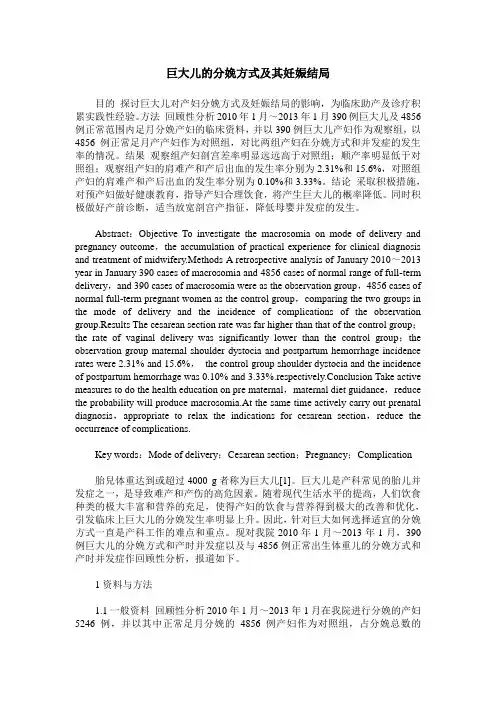
巨大儿的分娩方式及其妊娠结局目的探讨巨大儿对产妇分娩方式及妊娠结局的影响,为临床助产及诊疗积累实践性经验。
方法回顾性分析2010年1月~2013年1月390例巨大儿及4856例正常范围内足月分娩产妇的临床资料,并以390例巨大儿产妇作为观察组,以4856例正常足月产产妇作为对照组,对比两组产妇在分娩方式和并发症的发生率的情况。
结果观察组产妇剖宫差率明显远远高于对照组;顺产率明显低于对照组;观察组产妇的肩难产和产后出血的发生率分别为2.31%和15.6%,对照组产妇的肩难产和产后出血的发生率分别为0.10%和3.33%。
结论采取积极措施,对预产妇做好健康教育,指导产妇合理饮食,将产生巨大儿的概率降低。
同时积极做好产前诊断,适当放宽剖宫产指征,降低母婴并发症的发生。
Abstract:Objective To investigate the macrosomia on mode of delivery and pregnancy outcome,the accumulation of practical experience for clinical diagnosis and treatment of midwifery.Methods A retrospective analysis of January 2010~2013 year in January 390 cases of macrosomia and 4856 cases of normal range of full-term delivery,and 390 cases of macrosomia were as the observation group,4856 cases of normal full-term pregnant women as the control group,comparing the two groups in the mode of delivery and the incidence of complications of the observation group.Results The cesarean section rate was far higher than that of the control group;the rate of vaginal delivery was significantly lower than the control group;the observation group maternal shoulder dystocia and postpartum hemorrhage incidence rates were 2.31% and 15.6%,the control group shoulder dystocia and the incidence of postpartum hemorrhage was 0.10% and 3.33%.respectively.Conclusion Take active measures to do the health education on pre maternal,maternal diet guidance,reduce the probability will produce macrosomia.At the same time actively carry out prenatal diagnosis,appropriate to relax the indications for cesarean section,reduce the occurrence of complications.Key words:Mode of delivery;Cesarean section;Pregnancy;Complication胎兒体重达到或超过4000 g者称为巨大儿[1]。
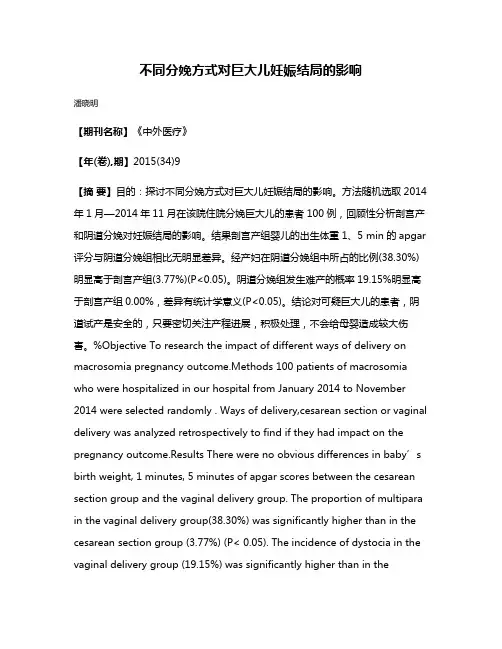
不同分娩方式对巨大儿妊娠结局的影响潘晓明【期刊名称】《中外医疗》【年(卷),期】2015(34)9【摘要】目的:探讨不同分娩方式对巨大儿妊娠结局的影响。
方法随机选取2014年1月—2014年11月在该院住院分娩巨大儿的患者100例,回顾性分析剖宫产和阴道分娩对妊娠结局的影响。
结果剖宫产组婴儿的出生体重1、5 min的apgar 评分与阴道分娩组相比无明显差异。
经产妇在阴道分娩组中所占的比例(38.30%)明显高于剖宫产组(3.77%)(P<0.05)。
阴道分娩组发生难产的概率19.15%明显高于剖宫产组0.00%,差异有统计学意义(P<0.05)。
结论对可疑巨大儿的患者,阴道试产是安全的,只要密切关注产程进展,积极处理,不会给母婴造成较大伤害。
%Objective To research the impact of different ways of delivery on macrosomia pregnancy outcome.Methods 100 patients of macrosomia who were hospitalized in our hospital from January 2014 to November 2014 were selected randomly . Ways of delivery,cesarean section or vaginal delivery was analyzed retrospectively to find if they had impact on the pregnancy outcome.Results There were no obvious differences in baby’s birth weight, 1 minutes, 5 minutes of apgar scores between the cesarean section group and the vaginal delivery group. The proportion of multipara in the vaginal delivery group(38.30%) was significantly higher than in the cesarean section group (3.77%) (P< 0.05). The incidence of dystocia in the vaginal delivery group (19.15%) was significantly higher than in thecesarean section group(0.00%)(P<0.05).Conclusion As to patients who were suspected of macrosomia, vaginal delivery was safe. If we paid close attention to the progress of labor and deal with it positively, there would not bring big damage to mother and baby.【总页数】2页(P73-74)【作者】潘晓明【作者单位】浙江大学医学院附属妇产科医院妇产科,浙江杭州 310006【正文语种】中文【中图分类】R4【相关文献】1.不同分娩方式巨大儿对初产妇盆膈裂孔的近期影响 [J], 林冲;王兴田2.230例巨大儿不同分娩方式对造成母婴并发症的影响 [J], 潘亚琴3.产前预测巨大儿及经不同分娩方式对分娩结局的影响 [J], 易子云;刘娴;周岩;严滨4.巨大儿不同分娩方式对母婴结局的影响分析 [J], 殷春霞5.孕妇B族链球菌感染情况及不同分娩方式对妊娠结局的影响 [J], 王佩佩;童郁;林建萍因版权原因,仅展示原文概要,查看原文内容请购买。
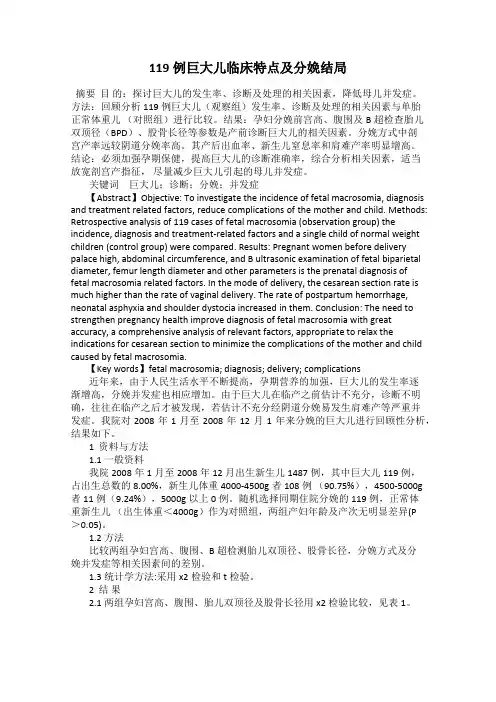
119例巨大儿临床特点及分娩结局摘要目的:探讨巨大儿的发生率、诊断及处理的相关因素,降低母儿并发症。
方法:回顾分析119例巨大儿(观察组)发生率、诊断及处理的相关因素与单胎正常体重儿(对照组)进行比较。
结果:孕妇分娩前宫高、腹围及B超检查胎儿双顶径(BPD)、股骨长径等参数是产前诊断巨大儿的相关因素。
分娩方式中剖宫产率远较阴道分娩率高。
其产后出血率、新生儿窒息率和肩难产率明显增高。
结论:必须加强孕期保健,提高巨大儿的诊断准确率,综合分析相关因素,适当放宽剖宫产指征,尽量减少巨大儿引起的母儿并发症。
关键词巨大儿;诊断;分娩;并发症【Abstract】Objective: To investigate the incidence of fetal macrosomia, diagnosis and treatment related factors, reduce complications of the mother and child. Methods: Retrospective analysis of 119 cases of fetal macrosomia (observation group) the incidence, diagnosis and treatment-related factors and a single child of normal weight children (control group) were compared. Results: Pregnant women before delivery palace high, abdominal circumference, and B ultrasonic examination of fetal biparietal diameter, femur length diameter and other parameters is the prenatal diagnosis offetal macrosomia related factors. In the mode of delivery, the cesarean section rate is much higher than the rate of vaginal delivery. The rate of postpartum hemorrhage, neonatal asphyxia and shoulder dystocia increased in them. Conclusion: The need to strengthen pregnancy health improve diagnosis of fetal macrosomia with great accuracy, a comprehensive analysis of relevant factors, appropriate to relax the indications for cesarean section to minimize the complications of the mother and child caused by fetal macrosomia.【Key words】fetal macrosomia; diagnosis; delivery; complications近年来,由于人民生活水平不断提高,孕期营养的加强,巨大儿的发生率逐渐增高,分娩并发症也相应增加。

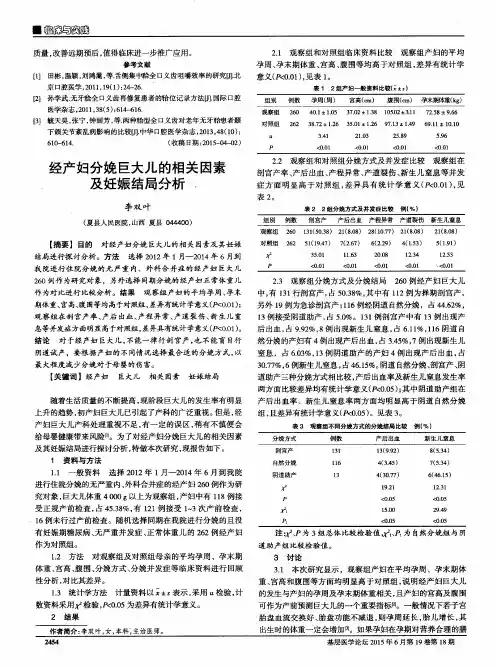
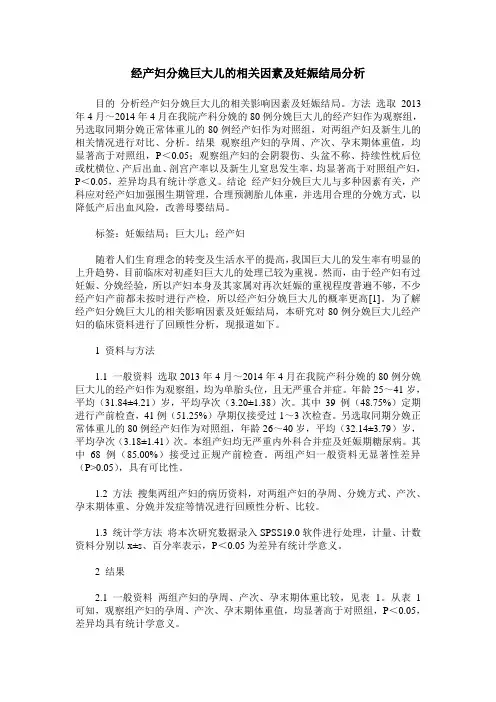
经产妇分娩巨大儿的相关因素及妊娠结局分析目的分析经产妇分娩巨大儿的相关影响因素及妊娠结局。
方法选取2013年4月~2014年4月在我院产科分娩的80例分娩巨大儿的经产妇作为观察组,另选取同期分娩正常体重儿的80例经产妇作为对照组,对两组产妇及新生儿的相关情况进行对比、分析。
结果观察组产妇的孕周、产次、孕末期体重值,均显著高于对照组,P<0.05;观察组产妇的会阴裂伤、头盆不称、持续性枕后位或枕横位、产后出血、剖宫产率以及新生儿窒息发生率,均显著高于对照组产妇,P<0.05,差异均具有统计学意义。
结论经产妇分娩巨大儿与多种因素有关,产科应对经产妇加强围生期管理,合理预测胎儿体重,并选用合理的分娩方式,以降低产后出血风险,改善母婴结局。
标签:妊娠结局;巨大儿;经产妇随着人们生育理念的转变及生活水平的提高,我国巨大儿的发生率有明显的上升趋势,目前临床对初產妇巨大儿的处理已较为重视。
然而,由于经产妇有过妊娠、分娩经验,所以产妇本身及其家属对再次妊娠的重视程度普遍不够,不少经产妇产前都未按时进行产检,所以经产妇分娩巨大儿的概率更高[1]。
为了解经产妇分娩巨大儿的相关影响因素及妊娠结局,本研究对80例分娩巨大儿经产妇的临床资料进行了回顾性分析,现报道如下。
1 资料与方法1.1 一般资料选取2013年4月~2014年4月在我院产科分娩的80例分娩巨大儿的经产妇作为观察组,均为单胎头位,且无严重合并症。
年龄25~41岁,平均(31.84±4.21)岁,平均孕次(3.20±1.38)次。
其中39例(48.75%)定期进行产前检查,41例(51.25%)孕期仅接受过1~3次检查。
另选取同期分娩正常体重儿的80例经产妇作为对照组,年龄26~40岁,平均(32.14±3.79)岁,平均孕次(3.18±1.41)次。
本组产妇均无严重内外科合并症及妊娠期糖尿病。
其中68例(85.00%)接受过正规产前检查。
巨大儿分娩方式及其妊娠结局朱贝利;李茉;王永珍;步仰高【期刊名称】《中国优生与遗传杂志》【年(卷),期】2000(8)3【摘要】目的 :探讨巨大儿的分娩方式与妊娠结局的关系。
方法 :对于 10 4例巨大儿进行回顾性分析。
结果 :巨大儿发生率 4 9% (10 4:2 132 ) ,呈逐年上升趋势 ,95年、96年、97年、98年分别为 3 2 %、2 5 %、6 5 %、6 7%。
本文巨大儿组手术产 ,产后出血 ,新生儿窒息发生率分别为 71 2 %、7 6 %、6 7% ,明显高于单胎非巨大儿组 (P <0 .0 1) ,直接影响母儿预后。
结论 :巨大儿的发生与母儿体重、孕周有关 ,更主要的是孕期营养吸收与消耗在妊娠基础上的失衡所致。
因此定期的产前检查 ,指导孕妇科学膳食 ,合理营养 ,适量活动 ,适时分娩是预防巨大儿发生的有效措施。
提高巨大儿的产前诊断率 ,选择适宜的分娩方式 ,适当放宽剖宫产指征 ,是减少分娩并发症 ,保证母儿安全的重要环节。
【总页数】2页(P83-84)【关键词】巨大儿;分娩方式;妊娠结局【作者】朱贝利;李茉;王永珍;步仰高【作者单位】解放军第105医院【正文语种】中文【中图分类】R714.4【相关文献】1.不同分娩方式对巨大儿妊娠结局的影响 [J], 潘晓明2.巨大儿的分娩方式及其妊娠结局 [J], 白颖3.探讨巨大儿的分娩方式对母婴妊娠结局造成的影响 [J], 李雪4.巨大儿产生相关危险因素及不良妊娠结局和分娩方式选择 [J], 黄俊英5.导致产妇分娩巨大儿的影响因素及分娩巨大儿对其妊娠结局的影响 [J], 庄梦君因版权原因,仅展示原文概要,查看原文内容请购买。
高龄经产妇巨大儿的相关因素及妊娠结局分析目的探讨二胎政策下高龄经产妇分娩巨大儿的相关因素及妊娠结局。
方法回顾性分析2015年10月— 2016年9月在郑州大学第三附属医院(以下简称“该院”)分娩巨大儿(胎儿出生体重≥4 000 g)的112例高龄经产妇的分娩资料作为研究组,并与同期分娩正常体重儿(2 500 g≤出生体重0.05)。
1.2 方法对研究组和对照组孕妇分娩孕龄、孕次、产次、分娩方式、母婴结局、瘢痕子宫再次妊娠率、产检次数等进行回顾性对比分析。
1.3 统计方法采用SPSS 21.0统计学软件进行数据分析,计量资料采用两独立样本t检验,计数资料采用χ2检验,以P<0.05为差异有统计学意义。
2 结果2.1 研究组和对照组临床资料比较研究组分娩孕龄、产次均高于对照组,其差异有统计学意义(P<0.05);而孕次虽高于对照组,但其差异无统计学意义(P>0.05)。
见表1。
2.2 研究组和对照组妊娠结局、瘢痕子宫再妊娠率、产检次数比较研究组中妊娠期糖尿病、新生儿窒息、胎儿窘迫发生率均高于对照组,产检≥5次低于对照组,差异有统计学意义(P<0.05);而剖宫产发生率、瘢痕子宫再妊娠率虽高于对照组,但差异无统计学意义(P>0.05)。
见表2。
2.3 研究组和对照组经阴道分娩情况比较研究组经阴道分娩者32例(28.57%),对照组经阴道分娩者366例(33.21%),差异无统计学意义(P<0.05)。
研究组中经阴道分娩者的总产程、产时及产后2 h 出血量、羊水量均高于对照组,其差异有统计学意义(P<0.05)。
见表3。
3 讨论3.1 二胎政策下高龄经产妇增多二胎政策全面实施后,越来越多符合生育政策的家庭计划生育二胎。
根据统计,现阶段全国有1 600~2 100万生育一孩的夫妇,其中约有65%左右的夫妇期望生育二胎,大約每年将会增加110~210万孩子[2],而其中超过35岁的女性占大多数。
350例巨大儿诊断与分娩结局分析目的通过对350例巨大儿(新生儿体重≥4000g )的临床分析,探讨巨大儿的产前预测及分娩方式,减少母儿并发症。
方法对2012年1月~2013年12月在本院分娩的350例巨大儿进行回顾性分析,并对其中进行试产的130例与正常体重儿组进行比较,比较剖宫产率、产后出血率、产伤、新生儿窒息率。
结果巨大儿阴道试产风险较高,经阴道分娩并发症高于正常体重儿组。
结论产妇分娩时宫高、腹围、双顶径及股骨长是产前预测巨大儿的相关因素,超声检查对预测巨大儿有参考价值,巨大儿阴道分娩风险较大,分娩方式以剖宫产为相对安全。
标签:巨大儿;产前预测;阴道试产巨大儿是产科常见的胎儿并发症之一,是难产及产伤的高危因素。
近年来,由于生活水平的提高,及孕妇注意休息,运动减少,营养摄人增多,近年来有明显上升趋势。
为了提高产前诊断巨大儿的准确性,及减少巨大儿分娩的母婴并发症。
现将我院分娩巨大儿350例做回顾性分析,争取产前做出准确的预测,选择正确的分娩方式,降低母儿并发症。
1 资料与方法1.1一般资料2012年1月~2013年12月我院产科共分娩新生儿6308例,其中巨大儿350例,发生率为5.5%,其中>4500g 58例,发生率0.92%,占巨大儿的16.6%。
350例巨大儿中,剖宫产260例,剖宫产率74.3%。
其中未经试产而行择期剖宫产的219例,占巨大儿总数的62.6%。
经阴道试产者131例,同期选取头位、非疤痕子宫、无重度子痫前期等合并症产妇150例分娩2500~4000g 之间正常体重的产妇作为对照组,比较巨大儿组及正常体重儿组试产成功率及新生而窒息率等,两组在孕产次及年龄及孕周方面无明显差异。
1.2产前诊断标准①B超檢查双顶径(BPD)及FL的和大于165mm;②宫高加腹围>140cm;③宫高×腹围+200。
1.3统计学方法采用χ2检验。
2 结果2.1产前诊断符合率350例巨大儿中,按双顶径+股股长>165mm诊断符合率247/350,70.6%,按宫高×腹围+200诊断符合率204/350,58.3%,按宫高加腹围>140cm诊断符合243/350,69.4%,按宫高>35,符合232/350,产前诊断符合率为66.3%。
经产妇分娩巨大儿的相关因素及妊娠结局探究目的:探讨导致经产妇分娩巨大婴儿的相关因素,以及与妊娠结局二者之间的关系。
方法:收集2010年2月-2013年3月笔者所在医院经产妇所分娩的巨大婴儿的资料,经产妇均无妊娠期糖尿病及无严重的内、外科合并症。
与同期经产妇所分娩的正常体重婴儿以及初产妇分娩的巨大婴儿进行统计、比较、分析。
结果:经产妇正常儿组产次、孕龄、孕末期体重低于经产妇巨大儿组(P<0.05)。
经产妇巨大儿组胎位异常率、剖宫产率、产后出血率、新生儿窒息率,均明显高于经产妇正常儿组(P<0.05)。
与初产妇巨大儿组进行比较,经产妇巨大儿组正规产检的次数明显少,剖宫产率、逾期妊娠率及新生儿窒息率明显高(P<0.05)。
结论:在经产妇围产期时加强管理,要对产妇具体情况进行分析,合理膳食、进行正规的产前检查,并根据相关指标来选择适合的分娩方式,才能降低产妇产后出血率、新生儿窒息率及母婴并发症等。
[Abstract] Objective:To investigate the factors leading to macrosomia by multipara delivery and pregnancy outcomes and the relationship between them.Method:The clinical information of macrosomia by multipara delivery from February 2010 to March 2013 in author’s hospital were selected,the multipara were no gestational diabetes and no serious internal and surgical complications.With the same period of multipara normal baby and primipara macrosomia comparison and analysis.Result:The number of births,gestational age,late pregnancy weight of multipara normal baby group were lower than that of multipara macrosomia group(P <0.05).The abnormal fetal position rate,cesarean section rate,postpartum hemorrhage rate,neonatal asphyxia rate of multipara macrosomia group were higher than that of multipara normal baby group(P<0.05).Compared with the primipara macrosomia group,the number of regular check of multipara macrosomia group was significantly reduced,cesarean section rate,late pregnancy rate and neonatal asphyxia rate of multipara macrosomia group were significantly increased(P<0.05).Conclusion:Strengthening maternal prenatal management at the time,analyze the specific situation of women,reasonable diet,conduct regular prenatal care,and in accordance with the relevant indicators to select the appropriate mode of delivery,can reduce the rate of maternal postpartum hemorrhage,neonatal asphyxia and prenatal complications.[Key words] Multipara;Macrosomia;Delivery method;Pregnancy outcome隨着现今社会的进步及人们对生活要求的日益提高,优生优育以及儿童健康成长已成为其社会各界密切关注的焦点。
巨大儿分娩方式影响妊娠结局的分析摘要】目的对巨大儿分娩方式与妊娠结局的关系进行分析和探讨。
方法此次临床主要以我院收治的2518例分娩产妇为研究对象,其中巨大儿有276例,对276例巨大儿与正常体重儿进行比较。
结果巨大儿分娩在剖宫产率、住院天数、产后出血情况以及新生儿窒息情况均比正常分娩要高,在阴道助产率方面,巨大儿分娩明显高于正常分娩,但不具统计学意义。
巨大儿分娩的出血情况以及巨大儿窒息情况均与分娩方式无关。
结论巨大儿分娩容易导致母婴并发症,因此在产前需要对巨大儿进行合理预测,加强产时工作。
【关键词】巨大儿分娩方式影响在目前,巨大儿的发生率日益增长[1]。
巨大儿的出现导致母婴并发症的机率提高,危及了产妇和婴儿的生命安全。
巨大儿容易导致产妇出现子宫破裂、产程停滞、产程延长以及软产道裂伤等情况,也会使产妇的产后出血以及产褥感染等机率增加。
婴儿也会出现颅内出血、窒息以及锁骨骨折等情况。
因此医护人员需要加强重视力度。
1 资料与方法1.1 一般资料此次临床主要以我院在2010年1月份到2012年1月份收治的2518例分娩产妇为研究对象,其中巨大儿有276例,占11.0%。
产妇的年龄范围为22岁到27岁,平均年龄为26岁。
1.2 方法采用调查表的方式对产妇进行统一调查,并填写调查表,调查对象为2528例分娩产妇,其中包括276例巨大儿和2252例正常婴儿。
1.3 诊断标准巨大儿的判断标准为婴儿出生体重大于或等于4千克的新生儿;正常体重的婴儿的体重大于或等于2.5千克并小于4千克。
1.4 统计学方法此次临床研究主要采用SPSS13.0软件对数据进行分析和处理,计量资料采用t检验,以P<0.05表示差异有统计学意义。
2 结果2.1 分娩方式巨大儿与正常体重儿的分娩方式如下表所示:由上述表格可以看出,巨大儿的的剖宫产率为79.71%,明显高于正常体重儿的剖宫产率为62.21%,具有统计学意义(P<0.05)。
巨大儿的分娩方式及其妊娠结局作者:白颖来源:《医学信息》2017年第09期摘要:目的探讨巨大儿对产妇分娩方式及妊娠结局的影响,为临床助产及诊疗积累实践性经验。
方法回顾性分析2010年1月~2013年1月390例巨大儿及4856例正常范围内足月分娩产妇的临床资料,并以390例巨大儿产妇作为观察组,以4856例正常足月产产妇作为对照组,对比两组产妇在分娩方式和并发症的发生率的情况。
结果观察组产妇剖宫差率明显远远高于对照组;顺产率明显低于对照组;观察组产妇的肩难产和产后出血的发生率分别为2.31%和15.6%,对照组产妇的肩难产和产后出血的发生率分别为0.10%和3.33%。
结论采取积极措施,对预产妇做好健康教育,指导产妇合理饮食,将产生巨大儿的概率降低。
同时积极做好产前诊断,适当放宽剖宫产指征,降低母婴并发症的发生。
关键词:分娩方式;剖宫产;妊娠;并发症The Mode of Delivery and Pregnancy Outcome of MacrosomiaBAI Ying(Department of Obstetrics and Gynecology,Baodi District of Maternity Hospital,Tianjin 301800,China)Abstract:Objective To investigate the macrosomia on mode of delivery and pregnancy outcome,the accumulation of practical experience for clinical diagnosis and treatment of midwifery.Methods A retrospective analysis of January 2010~2013 year in January 390 cases of macrosomia and 4856 cases of normal range of full-term delivery,and 390 cases of macrosomia were as the observation group,4856 cases of normal full-term pregnant women as the control group,comparing the two groups in the mode of delivery and the incidence of complications of the observation group.Results The cesarean section rate was far higher than that of the control group;the rate of vaginal delivery was significantly lower than the control group;the observation group maternal shoulder dystocia and postpartum hemorrhage incidence rates were 2.31% and 15.6%, the control group shoulder dystocia and the incidence of postpartum hemorrhage was 0.10% and3.33%.respectively.Conclusion Take active measures to do the health education on pre maternal,maternal diet guidance,reduce the probability will produce macrosomia.At the same time actively carry out prenatal diagnosis,appropriate to relax the indications for cesarean section,reduce the occurrence of complications.Key words:Mode of delivery;Cesarean section;Pregnancy;Complication胎儿体重达到或超过4000 g者称为巨大儿[1]。
巨大儿是产科常见的胎儿并发症之一,是导致难产和产伤的高危因素。
随着现代生活水平的提高,人们饮食种类的极大丰富和营养的充足,使得产妇的饮食与营养得到极大的改善和优化,引发临床上巨大儿的分娩发生率明显上升。
因此,针对巨大如何选择适宜的分娩方式一直是产科工作的难点和重点。
现对我院2010年1月~2013年1月,390例巨大儿的分娩方式和产时并发症以及与4856例正常出生体重儿的分娩方式和产时并发症作回顾性分析,报道如下。
1资料与方法1.1一般资料回顾性分析2010年1月~2013年1月在我院进行分娩的产妇5246例,并以其中正常足月分娩的4856例产妇作为对照组,占分娩总数的92.57%;以巨大儿分娩的产妇390例作为观察组,占分娩总数的7.43%。
产妇年龄在19~38岁,平均年龄(27.3±3.8)岁。
3年间产后出血共发生223例,发生率4.25%,其中正常出生体重儿发生产后出血162例,发生率3.33%;巨大儿发生产后出血61例,发生率15.60%。
分娩巨大儿的产妇中,发生新生儿窒息1例,发生率0.25%;正常出生体重儿中新生儿窒息8例,发生率1.16%。
巨大儿中剖宫产分娩272例,其中发生产后出血23例,发生率8.46%;顺产分娩118例,发生产后出血38例,发生率32.20%。
正常体重儿中,剖宫产分娩1990例,发生产后出血59例,发生率2.96%;顺产分娩2866例,发生产后出血103例,发生率3.59%。
巨大儿发生肩难产9例,正常体重儿发生肩难产5例。
两组产妇在年龄等一般性临床资料方面无显著性差异,具有可比性(P>0.05)。
1.2方法统计分析所有产妇的临床资料,并记录她们的分娩方式,包括顺产和剖宫产,以及产后并发症的发生情况,如肩难产、产后出血、新生儿窒息等。
1.3统计学处理采用统计软件SPSS19.0进行数据分析,计量数据检测结果以(x±s)表示,进行t检验,计数资料使用χ2检验,P2结果2.1两组产妇的分娩方式对比通过数据分析可以看出,观察组产妇剖宫差率明显远远高于对照组,差异具有统计学意义(P2.2两组产妇的并发症发生率对比通过数据分析可以看出,观察组产妇的肩难产和产后出血的发生率分别为2.31%和15.60%,对照组产妇的肩难产和产后出血的发生率分别为0.10%和3.33%,两组间比较,差异具有统计学意义(P0.05),见表2。
3讨论在本次研究中,390例巨大儿的观察组产妇的剖宫产率、产后出血、胎儿窘迫发生率均远远高于对照组,两组间相比较,差异具有统计学意义(P0.05)。
这说明对于产妇,巨大儿会对分娩方式产生极大的影响,在产后的并发症发生情况也会较为严重,具体情况的分析如下。
3.1巨大儿对分娩方式的影响巨大儿由于潜在诸多风险,因此与分娩相关的问题应得到产科医生的足够重视。
临床上通过测量腹围、宫高以及先露高低计算胎儿体重,然而这种临床诊断方式的灵敏性与特异性并非百分之百,还是有可能出现各种并发症,如锁骨骨折、尾骨损伤、臂丛神经损伤以及新生儿窒息等。
此外,经阴道分娩的巨大儿还会增加会阴或宫颈裂伤及产后出血的发生率。
所以,选择合适的分娩方式是降低母婴并发症的重要举措。
3.2巨大儿的相关因素随着现代生活水平的提高,孕妇不重视合理饮食致使蛋白质、脂肪、碳水化合物等营养过剩造成孕妇体重增加明显,是发生巨大儿最重要的原因。
巨大儿是遗传和围产期多方面因素共同作用结果。
多方研究表明,母亲孕前体重、孕期增重与巨大儿的发生有关[2-3]。
因此,合理监测、控制孕期体重,减少巨大儿发生率是每位孕妇及临床产科医师都应予以重视的。
此外,有研究显示,经产妇胎儿体质量随着分娩次数的增多而增加[4],这可能与经产妇腹壁松弛有关。
3.3巨大儿剖宫产术的指征分析①胎位不正;②头盆不称或者是骨盆处狭窄,骨盆轻度狭窄者也要给予足够的重视;③糖尿病孕妇或者是过期妊娠孕妇发生巨大儿[5-6]。
在产程中需要严密的观察阴道分娩巨大儿情况,如产程异常及时处理,对胎儿体重进行再一次的评估分析,这样就可以在第一时间内发现巨大儿的存在,最大限度地降低分娩对母婴产生的损伤[7-8]。
综上所述,巨大儿对母婴危害较大,巨大儿造成难产、产后出血、胎儿锁骨骨折、新生儿窒息甚至死亡等。
巨大儿手术产率和死亡率均较正常胎儿明显增多,处理不当将导致母婴严重并发症。
在经产妇妊娠期及分娩期,临床医生必须充分认识对经产妇管理工作的重要性,采用必要的干预手段降低巨大儿的发生率,分娩期根据B型超声检查尽可能准确推算出胎儿的体重,结合骨盆决定分娩方式,以达到令人满意的妊娠结局。
参考文献:[1]韩素新,周剑利,陈海红,等.巨大儿出生体质量预测方法的评价[J].山东医药,2009,49(14):79-80.[2]韩红敬,工山米,魏丽惠,等.非妊娠糖尿病巨大胎儿影响因素的病例对照研究[J].中国妇产科临床杂志,2003,4(2):130.[3]郝淑,黄醒华.巨大胎儿相关因素研究进展[J].中国妇产科临床杂志, 2004,5(3):230.[4]Domma MM.Macrosomia,top of the iceberg:the charm of underlying factors[J].Pediatr Int,2011,53(1):78-84.[5]王俊婷,王树松,顾春雷,等.巨大儿168例临床探讨[J].中国优生与遗传杂志,2010,8(18):86-93.[6]李凤秋,殷世美,王静.巨大儿发病危险因素分析[J].中国急救复苏与灾害医学杂志,2015,8(8):732-734.[7]蒋玮.巨大儿的母婴并发症及预防[J].首都医药,2008,12(32):27-28.[8]鲍春丹,姜丽英,王凤华,等.巨大儿的分娩方式及其对妊娠结局的影响,中国妇幼保健,2009,24(23):3244-3246.编辑/李桦。